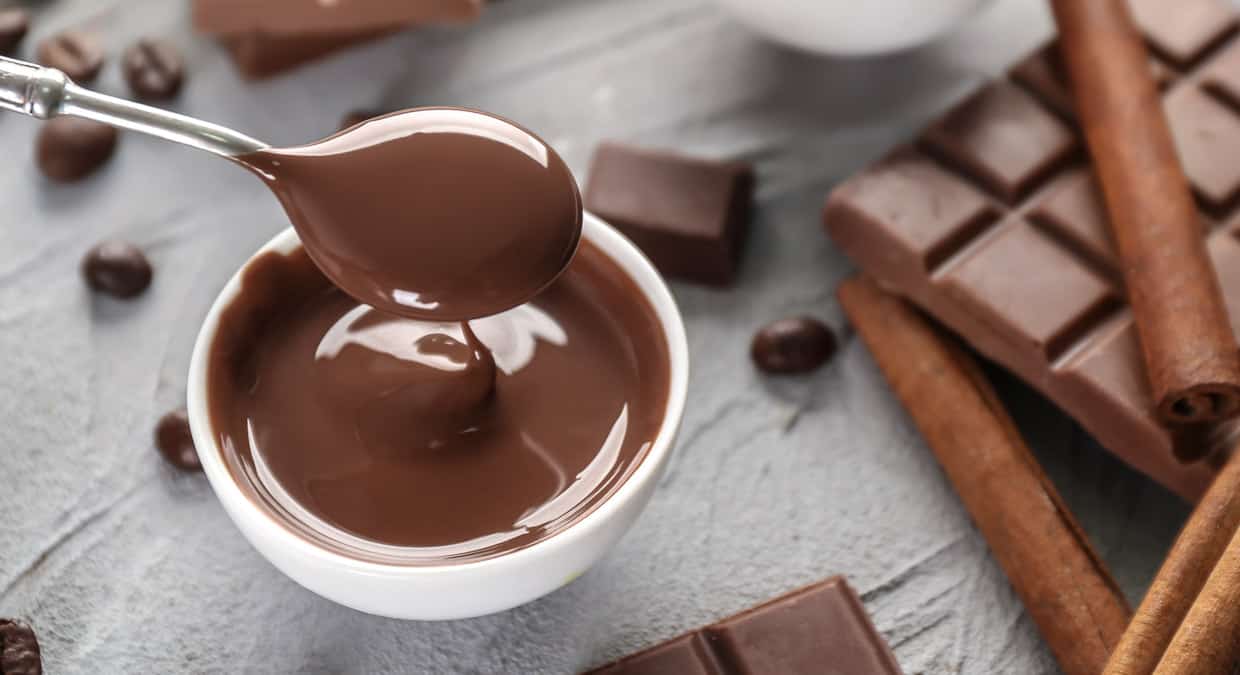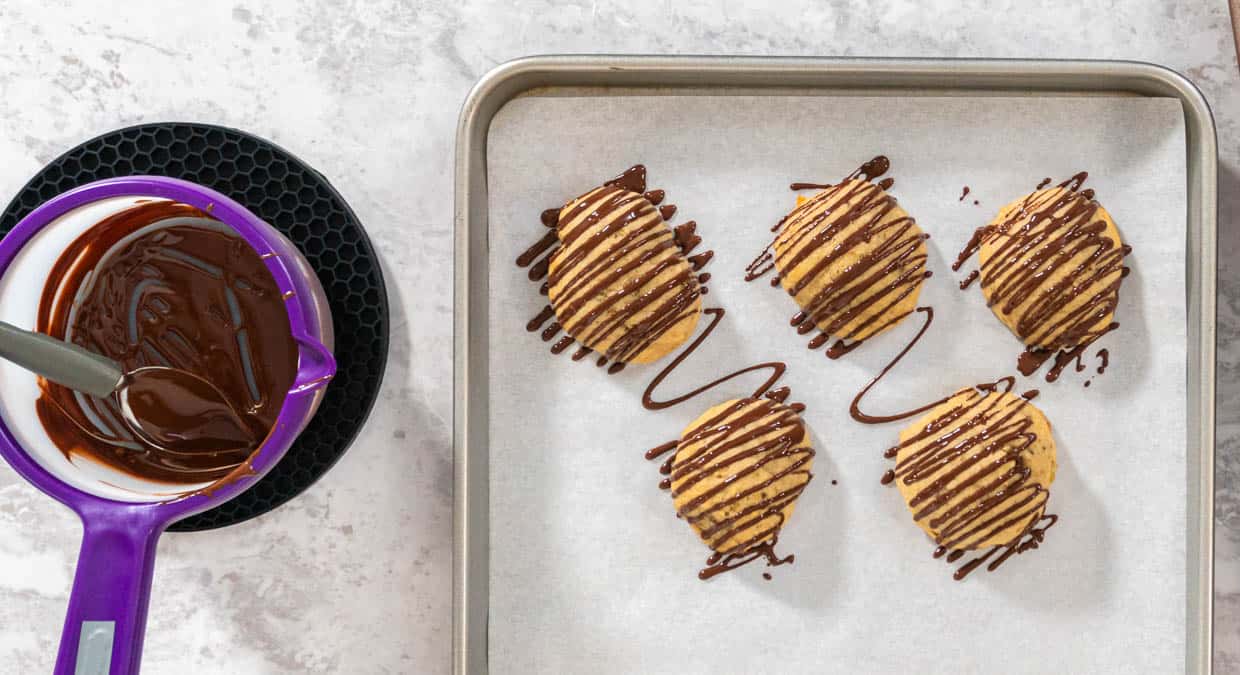Melting chocolate is like magic, transforming simple cocoa into a luscious treat that makes any dessert tastier. It’s the secret behind decadent truffles, silky ganache and many sweet delights. But learning how to melt chocolate is also a skill.

There’s more than one way to melt a bar of chocolate, and each has its tricks and traps. Keep reading to learn the top methods, ensuring a smooth, glossy finish perfect for every recipe.
How to melt chocolate
When melting chocolate, the first thing to decide is the method: the convenient microwave, the chef’s favorite double boiler or the hands-off slow cooker. Each method brings its own advantages and disadvantages.
How to melt chocolate in the microwave
Melting chocolate in the microwave is perfect for many at-home bakers. It’s fast and ideal for spur-of-the-moment baking sessions or a quick chocolate drizzle.
- First, chop the chocolate into small, evenly sized pieces. Place the pieces in a microwave-safe bowl and set the microwave to 50 percent power.
- Heat the chocolate in 15 to 30-second intervals, stirring between each interval. The residual heat will help melt some remaining bits, so mixing is crucial.
- Continue until the chocolate reaches a smooth consistency. Be especially careful when it gets close to melted since it can go from melted to burnt in seconds.

How to melt chocolate on the stovetop with a double boiler
Using a double boiler is a classic technique that offers precise control over the melting process. Since it uses indirect heat, the chocolate remains silky and avoids the risk of scorching.
- Fill a medium saucepan halfway with water and bring it to a simmer.
- Place a glass or heatproof bowl on top of the saucepan, ensuring the bowl does not touch the simmering water. A commercial double boiler is good to have but optional.
- Break or chop the chocolate into small pieces and add them to the bowl. Keep the water at a gentle simmer, just under boiling. The steam produced will heat the bowl and melt the chocolate.
- Stir the chocolate as it melts and continue stirring continuously with a rubber spatula until most of it has melted.
- Take the bowl off the heat and stir until smooth and glossy.
“Nothing will stop the fun of baking like scorching chocolate when you’re just trying to melt it. So, I never melt in anything other than a heatproof bowl over a pan of water over the lowest heat possible.”
— Laura Sampson, Little House Big Alaska
FDL’S 75 Best Bites

Our cookbook with 75 tasty recipes will be your go-to kitchen companion for easy dinners with ad-free recipes right at your fingertips. Crafted by experienced chefs and recipe developers, this collection offers a treasure trove of tried-and-true dishes that make mealtime a breeze.
Get the Recipe: FDL’S 75 Best Bites
How to melt chocolate in a slow cooker
Using a slow cooker is especially great for recipes that require a large amount of melted chocolate, as the slow cooker can easily handle bigger batches. It is also a hands-off method.
- Break the chocolate into small pieces and place them in the slow cooker.
- Put the lid on and let the crock pot heat undisturbed for about 3 hours on warm.
- Turn the lid off and let the slow cooker sit undisturbed for another 2 hours to allow the heat to spread through all the chocolate.
- Then, gently stir the chocolate until smooth.

Selecting the ideal chocolate for melting
Not all chocolate melts at the same temperature, so understanding the unique properties of different chocolates is essential. Most of these differences stem from the cocoa solids present in each type.
White chocolate and milk chocolate, with their lower cocoa butter composition, have the advantage of a lower melting point. Since this ensures a quicker melt, it reduces the risk of overheating or burning.
Conversely, ruby chocolate and dark chocolate have higher melting temperatures due to their higher cocoa butter content. Melting these chocolates can require more time stirring.
When choosing the right chocolate, consider its melting behavior and the desired flavor profile. White, milk and ruby chocolates are preferable for recipes demanding a subtle, creamy taste.
However, dark chocolate remains the top choice for those seeking a richer, more robust cocoa flavor. Its higher melting point means it takes longer to melt.
Tips to achieve the perfect melted chocolate
The end goal of melting chocolate is always the same: smooth, silky chocolate. These essential tips can help.
- Prepare the chocolate correctly: Cutting the chocolate into smaller, evenly sized pieces allows for a quicker, more even melt.
- Use quality chocolate: High-quality chocolate will provide a better taste and is more likely to melt smoothly. While chocolate chips are a convenient size for melting, chocolate bars tend to melt more evenly due to their more consistent composition.
- Avoid contact with water: Any moisture can cause the chocolate to seize, becoming stiff and grainy. To prevent this, ensure all utensils, bowls and pots are completely dry before starting.
- Add oil if needed: If you find your chocolate is too thick, add a small amount of coconut oil or vegetable oil to thin it out. Never add water.
- There is no best method: The best way to melt chocolate depends on the tools available, the amount of melted chocolate needed and what the chocolate will be used for.
“I use two different methods for melting chocolate. For small batches, I use the microwave and slowly melt the chocolate at 50 percent power for 20-second intervals. For melting big batches of chocolate, I will only use the double boiler technique so I can keep an eye on the chocolate as it melts.”
— Jere’ Cassidy, One Hot Oven

How to use melted chocolate
Use the magic of melted chocolate to turn everyday delights into gourmet wonders. Here are some ways to use it in your baking and decorating.
- Secret ingredient: Ever wonder what gives some cakes, cookies or creamy fudge that deep, rich flavor? It’s often the melted chocolate smoothly mixed into the batter.
- Artistic drizzles: Use a fork or a piping bag to drizzle melted chocolate over the tops of cookies, candy, cakes or even ice cream for an impressive finishing touch.
- Dip: From truffles to cookies to peanut butter balls, a simple dip in melted chocolate transforms them into a velvety treat. The chocolate hardens into a smooth, delicious outer coating, making for a decadent outer layer.
- Decorate: Use a piping bag filled with melted chocolate to pipe designs onto your cakes and cookies or even write messages for special occasions.
- Ganache: Mix the melted chocolate with cream to create a luxurious ganache to use as a topping for a cake or brownies.
Summing up
Mastering how to melt chocolate is an essential baking skill for making delicious desserts. Whether drizzling, dipping or mixing it into a batter, perfectly melted chocolate can make all the difference.
Anne Jolly is the creator of the food blog Upstate Ramblings. She loves to cook with gadgets like an air fryer, sous vide or pressure cooker. In her free time, she enjoys hiking, reading, knitting and spending time with her three kids.